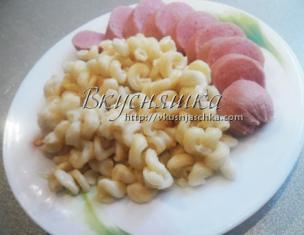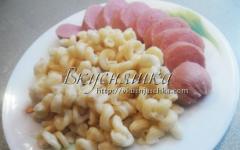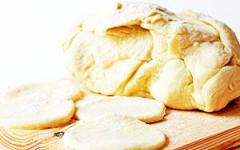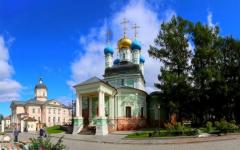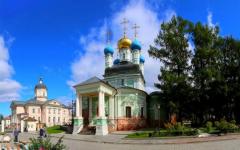Seed propagation in the garden strawberries we are used to, unfortunately, leads to the appearance of less productive plants and weaker bushes. But another type of these sweet berries, alpine strawberries, can be successfully grown from seeds. Let's learn about the main advantages and disadvantages of this crop, consider the main varieties and features of agricultural technology. The information presented in this article will help you decide whether it is worth allocating a place for it in the berry garden.
Often, when we see a beautiful flower, we instinctively bend down to smell its fragrance. All fragrant flowers can be divided into two large groups: nocturnal (pollinated by moths) and daytime, whose pollinators are mainly bees. Both groups of plants are important for the florist and designer, because we often walk around the garden during the day and relax in our favorite corners when evening comes. We are never overwhelmed by the scent of our favorite fragrant flowers.
Many gardeners consider pumpkin to be the queen of garden beds. And not only because of its size, variety of shapes and colors, but also for its excellent taste, healthy qualities and rich harvest. Pumpkin contains a large amount of carotene, iron, various vitamins and minerals. Thanks to the possibility of long-term storage, this vegetable supports our health all year round. If you decide to plant a pumpkin on your plot, you will be interested in learning how to get the largest possible harvest.
Scotch eggs - incredibly delicious! Try to prepare this dish at home, there is nothing difficult in preparation. Scotch eggs are a hard-boiled egg wrapped in minced meat, breaded in flour, egg and breadcrumbs and deep-fried. For frying, you will need a frying pan with a high side, and if you have a deep fryer, then that’s just great - even less hassle. You will also need oil for frying so as not to smoke in the kitchen. Choose farm eggs for this recipe.
One of the most amazing large-flowered tubs of Dominican Cubanola fully justifies its status as a tropical miracle. Warm-loving, slow-growing, with huge and in many ways unique bells of flowers, Cubanola is a fragrant star with a complex character. It requires special conditions in the rooms. But for those who are looking for exclusive plants for their interior, a better (and more chocolatey) candidate for the role of indoor giant cannot be found.
Chickpea curry with meat is a hearty hot dish for lunch or dinner, inspired by Indian cuisine. This curry is quick to prepare but requires some prep. The chickpeas must first be soaked in plenty of cold water for several hours, preferably overnight; the water can be changed several times. It is also better to leave the meat in the marinade overnight so that it turns out juicy and tender. Then you should boil the chickpeas until tender and then prepare the curry according to the recipe.
Rhubarb cannot be found in every garden plot. It's a pity. This plant is a storehouse of vitamins and can be widely used in cooking. What is not prepared from rhubarb: soups and cabbage soup, salads, delicious jam, kvass, compotes and juices, candied fruits and marmalade, and even wine. But that's not all! The large green or red rosette of leaves of the plant, reminiscent of burdock, acts as a beautiful background for annuals. It is not surprising that rhubarb can also be seen in flower beds.
Today, the trend is to experiment with unusual combinations and non-standard colors in the garden. For example, plants with black inflorescences have become very fashionable. All black flowers are original and specific, and it is important for them to be able to select suitable partners and location. Therefore, this article will not only introduce you to an assortment of plants with slate-black inflorescences, but will also teach you the intricacies of using such mystical plants in garden design.
3 delicious sandwiches - a cucumber sandwich, a chicken sandwich, a cabbage and meat sandwich - a great idea for a quick snack or for an outdoor picnic. Just fresh vegetables, juicy chicken and cream cheese and a little seasoning. There are no onions in these sandwiches; if you wish, you can add onions marinated in balsamic vinegar to any of the sandwiches; this will not spoil the taste. Having quickly prepared snacks, all that remains is to pack a picnic basket and head to the nearest green lawn.
Depending on the varietal group, the age of seedlings suitable for planting in open ground is: for early tomatoes - 45-50 days, average ripening - 55-60 and late ripening - at least 70 days. When planting tomato seedlings at a younger age, the period of its adaptation to new conditions is significantly extended. But success in obtaining a high-quality tomato harvest also depends on carefully following the basic rules for planting seedlings in open ground.
Unpretentious “background” plants of sansevieria do not seem boring to those who value minimalism. They are better suited than other indoor decorative foliage stars for collections that require minimal care. Stable decorativeness and extreme hardiness in only one species of sansevieria are also combined with compactness and very rapid growth - rosette sansevieria Hana. The squat rosettes of their tough leaves create striking clusters and patterns.
One of the brightest months of the garden calendar pleasantly surprises with the balanced distribution of favorable and unfavorable days for working with plants according to the lunar calendar. Vegetable gardening in June can be done throughout the entire month, while the unfavorable periods are very short and still allow you to do useful work. There will be optimal days for sowing and planting, for pruning, for a pond, and even for construction work.
Meat with mushrooms in a frying pan is an inexpensive hot dish that is suitable for a regular lunch and for a holiday menu. Pork will cook quickly, veal and chicken too, so this is the preferred meat for the recipe. Mushrooms - fresh champignons, in my opinion, are the best choice for homemade stew. Forest gold - boletus mushrooms, boletus and other delicacies is best prepared for the winter. Boiled rice or mashed potatoes are ideal as a side dish.
I love ornamental shrubs, especially unpretentious ones and with interesting, non-trivial foliage colors. I have various Japanese spirea, Thunberg barberries, black elderberry... And there is one special shrub, which I will talk about in this article - viburnum leaf. To fulfill my dream of a low-maintenance garden, it is perhaps ideal. At the same time, it is capable of greatly diversifying the picture in the garden, from spring to autumn.
On New Year's Eve, decorative miniature Canadian spruce trees planted in individual pots are very popular on sale. Any coniferous tree can be a symbol of the New Year's celebration, so such miniature trees are eagerly bought up in order to later decorate them with bright beads and take them with them on a visit as a present. Such a symbolic gift, if properly cared for, will delight you and your family with its pine aroma throughout the New Year holidays.
Spruce care.
At first, the New Year's plant needs to acclimatize; to do this, it is advisable to place it in the brightest and coolest place in the house. It’s a good idea to place the spruce in a pot on a glassed-in loggia, where the air temperature at night will not drop below 10C. Conifers prefer diffused light and need frequent ventilation of the room. Watering should be regular; under no circumstances should the soil be allowed to dry out, let alone become waterlogged; we can say that the soil should be evenly moistened. Canadian spruce reacts positively to increased air humidity. After the tree has recovered a little, it can be moved for a while to the room where the New Year celebration is planned in the future, and it will be the center of attention. To make the plant feel comfortable, it is advisable to return it to a cool windowsill or heated loggia at night.
In winter, a living, growing Christmas tree is at rest, so until mid-February you will not notice any changes in its development, but as spring approaches, it will actively begin to grow young branches throughout the crown that are lighter than its usual color. As soon as the spruce wakes up and begins to grow, you can begin to apply specialized fertilizers intended specifically for evergreen trees. I would like to draw your attention to the fact that when feeding coniferous plants, you must strictly follow the dosage specified in the instructions. Remember that a weak concentration of fertilizer will not allow the plant to develop properly, and a solution that is too concentrated can cause irreparable damage to the roots and branches of the plant. It is enough to water the spruce once with concentrated fertilizer, and after a while the plant may turn completely yellow and shed every single needle, and then die.
Replanting spruce. 
A spruce tree in a pot can be replanted only in the spring with the first warming, and even then it is quite painful to endure the replanting. The fact is that its root system is very vulnerable, all useful substances are absorbed from the soil by thin, non-woody roots, and if they are damaged during transplantation, they will die and will not recover. It is also important to know that loosening the soil around plants is strictly prohibited due to the fact that coniferous plants have a superficial capillary root system, so cultivation negatively affects the well-being of the plant. At first, the spruce may stop developing, then slowly begin to fade away and soon, as if from the inside, it will dry out and disappear. During transplantation, the speed of the process is considered an important point, since the roots of the plant, for the same reasons, should never be overdried. It is very important that the root collar is at soil level. After the plant is planted, it is recommended to water it abundantly and provide especially careful care during the first season. For better survival of spruce at first, during watering, you can use a root formation stimulator, as well as carry out foliar feeding.

You can transplant the Canadian spruce into a slightly larger pot in special soil for coniferous plants or plant it in a summer cottage, preferably in partial shade in a place that is not very windy. You can prepare soil for spruce yourself. The best option for planting coniferous plants is a mixture of turf soil, peat, humus, sand in a ratio of 2:2:2:1. Like all conifers, such miniature spruce trees develop rather slowly. From my observations, I can say that after transplanting into open ground, it took at least two years to take root. In the first years, until the Canadian spruce grew stronger, for the winter we wrapped it with pine branches and a special greenhouse cloth, and the tree trunk circle was mulched with cones and spruce needles that had previously fallen from mature coniferous trees.
Mostly trees with a height of 15-25 cm go on sale; it is these spruce trees that adapt more easily than older plants. The older the transplanted plant, the more difficult it is for it to take root and begin to grow. The most common species is the Canadian spruce "Konica". It has bright green needles and is easier to transplant than other spruce trees, and also does not need pruning, since it is a slowly growing specimen, therefore it retains its compactness and decorative appearance for a long time.
Problems in growing Canadian spruce.
If you notice that the needles have sharply turned yellow and begun to fall off, it means that you have violated the temperature regime. Another reason may be improper watering. The cooler the room where the plant is located, the less often and less watering is required. Unfortunately, the branches that have fallen off will not be restored; it is urgent to establish the cause of this state of the tree and change the conditions of maintenance as quickly as possible, otherwise the Canadian spruce will die.
Family: pine Division: coniferous Genus: spruce
Canadian spruce (white or gray) in nature. This type of spruce is of North American origin.
General description . At a young age, white spruce (gray or Canadian) grows quickly. At the age of 10 years it reaches a height of about 10 - 15 m, in some sources - up to 20 m, less often - up to 40 m. It has a regular cone-shaped crown. In younger plants, the branches are slightly raised and arranged regularly. In old spruce trees, the branches become somewhat drooping, and the crown becomes less regular, cylindrical in shape. The needles are short (about 1.0 - 1.8 cm), prickly, slightly curved, and their color is bluish-green or gray. It bears fruit from the age of 10. The cones are quite decorative; when mature they are light brown in color, up to 5-7 cm long.
Care and planting.
Has average soil and moisture requirements. Planted in sunny or partial shade. Frost resistance: zone 4 (up to -34.4 C°), decorative varieties are less resistant to frost (up to -28.8 C°), but are successfully grown in the middle zone with shelter for the winter.
Meaning . Canadian spruce is an ornamental plant, recommended for landscaping parks and creating hedges. For decorative purposes, both its natural appearance and various varieties obtained through selection are used..
Decorative varieties of white spruce, their photos, descriptions, requirements for planting and care(see photo below). Konika spruce is a famous dwarf spruce variety with a dense cone-shaped crown. It grows slowly. In the first few years it is distinguished by faster growth, which slows down over the years. In the first 10 years it grows up to 1 m in height. An adult tree grows to approximately 180 cm, rarely up to 2.5 m in height. It has thin, hard shoots and short green needles. Moderately demanding on soil and moisture. Can be used for growing in containers, rock gardens and heather gardens. Planted in sun or partial shade. Often suffers from pine spider mites, as well as spring sun rays. Frost resistance: zone 5A (up to -28.8 C°), suitable for growing in the middle zone, but with shelter for the winter..
Canadian spruce. variety "Alberta Globe"(see photo below). Dwarf variety with a spherical crown shape. In 10 years it reaches a diameter of about 30 cm. It has thin short shoots with short green needles (6 - 9 mm). Soil and moisture requirements are average. Used for planting in rock gardens and containers. Recommended for sunny and semi-shaded places. Frost resistance: zone 5A (up to -28.8 C°). In Russia it winters with shelter.
Canadian spruce. variety "Blue Planet"(see photo below). A miniature variety with a spherical crown of silver-bluish color. In 10 years it reaches a diameter of up to 20 cm. It has average soil and moisture requirements. It is better to plant in places protected from wind and midday sun. When planted in the shade, the needles lose their bluish color and become light green. Perfect for rock gardens and alpine slides. Frost resistance: zone 5A (up to -28.8 C°).
Canadian spruce. variety "Blue Wonder"(see photo below). A dwarf variety with a cone-shaped crown with silver-blue needles. At the age of 10 years it has a height of about 70 cm. It is moderately demanding of moisture and soil. Looks great in heather gardens and alpine hills. Planted in sun or partial shade. Frost resistance: zone 5A (up to -28.8 C°).
Canadian spruce. variety "Daisy's White"(see photo below). Comes from the popular variety "Konica" and has a cone-shaped crown. In 10 years it reaches about 80 cm in height. A characteristic feature is the yellow-white color of the first (spring) growths, which often burn from the sun's rays. Second (summer) growths are green. Moderately demanding on soil and moisture. Designed for planting in sun or partial shade. Recommended for decorating small gardens and rock gardens. Frost resistance: zone 5A (up to -28.8 C°).
Canadian spruce. variety "Echiniformis"(see photo below). Dwarf slow-growing variety. Young plants look like a dense bluish-green ball, then grow in breadth. At the age of 10 years, the diameter of the plant is 30 cm. An adult plant grows to approximately 50 cm in height and up to 1 m in diameter. Prefers moist soils with a slightly acidic reaction. Recommended for rock gardens, rock gardens or container growing. Grows in sun or partial shade. Frost resistance: zone 5A (up to -28.8 C°).
Canadian spruce. variety "Laurin"(see photo below). Slow growing variety with a narrow conical crown. In a year it grows 2 cm in height, and in 10 years - up to 40 cm. The needles are green. Has average soil and moisture requirements. Can be planted in both sun and partial shade. Frost resistance: zone 5A (up to -28.8 C°).
Canadian spruce. variety "Rainbow's End"(see photo below). In appearance, this variety is very similar to the popular Konica variety. It has the same cone-shaped crown. It grows slowly. In 10 years it reaches a height of about 1 m. A characteristic feature is two growths: spring and summer. Summer growths are characteristically yellow, and spring growths are green. Moderately demanding on soil and moisture. Suitable for planting in sun or partial shade. Recommended for rock gardens, alpine slides and small gardens. Frost resistance: zone 5A (up to -28.8 C°).
Canadian spruce. variety "Sanders Blue"(see photo below). A dwarf variety, it originates from the famous Konica variety. The crown shape is cone-shaped. A characteristic feature is the blue color of the needles. In 10 years it grows up to 70 cm in height. Soil and moisture requirements are average. Planted in sun or partial shade. Looks beautiful in heather and rocky gardens. Often suffers from pine spider mites. Frost resistance: zone 5A (up to -28.8 C°).
If a gardener dreams of decorating a live Christmas tree he has grown himself every New Year, then planting a konica spruce would be an excellent solution. A low cone-shaped tree goes well with various types of flowers and shrubs. Landscape designers plant the plant individually, as well as in small picturesque groups. The combination of Canadian spruce conica and echiniformis in sunny meadows is considered classic.
A little about the fluffy beauty
Canada is famous for its dense forests. More than a hundred years ago, travelers brought a small copy of the huge Canadian spruce - konika. The latter grows up to three meters only if all planting rules and quality care are followed. The compact tree is popular among breeders for its unpretentiousness and great decorative value.
Advice: if you bought a tree in a pot at the market, you can delay planting. A seedling with an open root system requires immediate placement in a hole.
Konica spruce grows only a few centimeters per year. As the plant matures, its growth slows down significantly. Gardeners rarely notice large cones (5.5-6 cm) - with proper care, the tree spends all its energy on the formation of shoots and needles of an unusual gray-emerald color. The needles are soft, not prickly, short (2 cm) and fragrant.
Which method of reproduction is better?
The easiest way to have a spruce tree in your home is to purchase your favorite specimen at the market. But for a true lover of green spaces, it is important to grow a tree yourself. Conica spruce, like Echiniformis, can be obtained from seeds. In the fall, ripe cones are collected, the seeds are dried and planted in seedling boxes to a depth of 1 cm. In a cool place, with moderate soil moisture, the first shoots will appear in three months.
Tip: young plants can be immediately planted in large pots. They will grow over the summer, but replanting will not be required with further care.

Stronger seedlings are obtained from cuttings; new trees will retain all the characteristics of the original sample. Together with a piece of bark, the lower branch of the spruce is cut off, and then the excess is removed, leaving 8-15 cm with a “heel” of bark. After drying the cutting, it is immersed in a solution of any growth stimulator for several hours. At this time, prepare a soil mixture of equal parts:
- leaf soil;
- bottom peat;
- river sand;
- turf.
The cuttings are planted in separate flowerpots, deepened by 2-3 cm. To properly care for the seedlings, you need to find a bright, cool place. Young plants need to be watered as the top layer dries; conic needles also like spraying. The tree will remain indoors for 3-4 years, and then it’s time to place the Canadian beauty on the lawn.

The best place for a Christmas tree
An excellent choice for planting a Canadian Christmas tree would be an area near the house. Soft diffused lighting predominates here. These trees, like Echiniformis, can be planted in open space, but only if the area is not characterized by hot summers. Cold piercing winds do not have the best effect on the conic tree.
Advice: trying to protect the plant from the heat, you should not plant it in a shady place. Even with high-quality care, a compact spruce will always stretch out and the needles will fall off.
Like its forest counterparts, the tree likes soil that is acidified and enriched with nutrients. Planting on land with slightly alkaline PH values will also not bring catastrophic consequences, but if there is an excess of lime on the site, it is better not to plant Canadian spruce at all. The hole must be made wide (up to 1 m), but shallow (up to 0.5 m), add a bucket of rotted manure there and dig it well.

Easy care
In the summer you need to pamper the konika spruce by giving it a soft shower with a hose. You can water the tree abundantly; 2-3 waterings weekly in the early morning or evening are enough. Young plants in closed ground are watered and sprayed frequently in the summer, and in winter the soil is only slightly moistened. Overwatering of the plant will inevitably result in death from rotting of the root system.
Spruce is sick if:
- The branches are covered with brown spots (rust).
- Needles (rot) rapidly fall off.
- The needles began to acquire a reddish tint (tracheomycosis).

Sick trees must be dug up and burned. Undamaged specimens are treated with a solution of a drug with fungicidal activity. The root system of Canadian spruce, like the roots of Echiniformis, is located shallow under the surface of the soil, so loosening must be careful. When loosening, you can apply organic fertilizers or complex fertilizers.
Advice: in late autumn it is necessary to wrap the crown of the Canadian spruce with breathable material (burlap). Reflecting from the ice crystals, the sun's rays burn the fragile needles.
The Canadian Christmas tree has remarkable quality for care - it requires virtually no pruning. The conical crown of the tree grows evenly; if you have to cut it, it’s only a couple of stray branches. In spring and autumn, gardeners carry out a preventive inspection of the plant, and also remove dry shoots and needles. You can immediately mulch the soil surface under the spruce with peat, leaves, and sawdust.

Konik spruce, like Echiniformis, is so unpretentious that it can be planted in the fall. The species is frost-resistant, suitable for planting in the middle latitudes of our country. Spruce has been growing in one place for about three hundred years. So, the grandfather can safely tell his grandson about tree care.
Caring for a konica spruce is equivalent to a health walk. Inhaling the aroma of needles, a person receives a boost of energy for the whole day. If you plant tall trees in the background and create a flower bed in front of the spruce, the garden will look elegant. A magic tree in a pot for the New Year will be a surprise for the household.
Botanical name: Canadian spruce or blue spruce
Homeland: North America
Lighting: afraid of bright sunlight
The soil: loamy
Watering: moderate
Max Height: 40 m
Average life expectancy: 300 years
Landing: cuttings
The arial of this evergreen tree is the northern regions of North America. It can be found on the banks of rivers and lakes, in the forest zone, where it forms mixed and pure plantings. Russian gardeners liked Canadian spruce. But not everyone knows that this plant has the following synonyms: gray or white spruce. In terms of decorative qualities, this type of conifer is slightly inferior to the prickly spruce, which has become widespread in Russia.
Description of Canadian firs
Canadian spruce trees are winter-hardy and drought-resistant trees. Under good conditions, life expectancy can be 300-500 years. For more than three hundred years, gray spruce has been successfully cultivated in Europe, where it was brought from Canada. In this regard, the plant got its name “Canadian”.
The height of the tree is 15-20 m, specimens 40 m high are very rare. The trunk width is 60-120 cm in diameter. The crown is dense, thick, regular cone-shaped. Young trees have branches directed upwards, while old trees have branches directed downward. The bark on the trunk is scaly and ash-brown. Young shoots are light brown or yellowish in color. The cones are non-resinous, spherical, up to 6 mm in length and up to 5 mm in width. Despite the fact that they are small, they are elegant and numerous. The needles are bluish-green, densely spaced and quite rigid. The needles are 10-18 mm long, slightly curved, and smell sharp when rubbed. Some people say the smell is reminiscent of black currants. The needles last for about 5-7 years. The cones ripen by September. They may first appear on an 8-year-old tree, but by the age of 11 they are obligatory. Unlike other types of conifers, cones can grow not only at the top, but also at the bottom.
Gray spruce: care and reproduction
It is recommended to plant Canadian Christmas trees with slight shade, as in the open sun the plant can get sunburn. This is especially likely in winter with little snow and in spring, when solar activity increases. Therefore, it is very important to build a preventive shelter for spruce trees from the harmful effects of ultraviolet radiation. Compared to European spruce, it is less sensitive to the effects of gas and smoke. It withstands strong winds well, so it can be used as a windbreak.
Loams and other soils with a humus layer can be used as soil. Low-fertility, dry, calcareous and dense soils are not suitable. Gray spruce is a moisture-loving plant and prefers soil that retains moisture well. But such soil must be well-drained, since swampy soil with close contact with groundwater is not suitable for conifers. But in the absence of rain for a long time, it is recommended to water.
Canadian spruce is propagated by cuttings. Cuttings are best done in early June. Cuttings planted at this time have time to create callus before the autumn cold. Next year the first weak roots will appear from this callus.
When cutting Canadian spruce, you need to adhere to certain conditions:
The matured lower branches, the size of which does not exceed 10-12 cm, are taken from the mother plant for cuttings;
The cutting separated from the mother plant must have a “heel”, otherwise it will quickly die;
The lower part of harvested cuttings can be treated with growth stimulants. After treating the cuttings with a stimulant, the remaining solution can be diluted with water and used for further watering of containers with planted cuttings;
Planting cuttings involves deepening their lower part into the substrate to a depth of 2-2.5 cm;
An important point when caring for planted cuttings is proper watering, in which the substrate should not dry out as the plants take root, but you should not over-water the soil either.
Canadian spruce: photos and types
The varietal forms bred by breeders are very diverse and decoratively beautiful. The artificial forms of Canadian Christmas trees have different crown configurations and different heights. The crown can have a conical, spherical, cushion shape. The color of the needles varies from light green to bluish-blue. In landscape design, Canadian spruces are used in a variety of ways: in group plantings and look good as a single plant.
Particularly popular among gardeners is the Canadian dwarf spruce, which is even grown in flower beds. Such small Christmas trees go well with heathers and heathers; in addition, these forms are suitable for growing in pots. Compact decorative forms are appropriate even among plants on an alpine hill.
The most common types of Canadian spruce:
"Conica" decorative form up to 2 m high, narrow conical crown diameter – 2 m.
"Laurin" - the Christmas tree is only 40 cm high, the crown is narrow-conical.

"Zucerhut" - plant up to 1.5 m, crown diameter up to 0.8 m, crown shape – conical.

"Sander's Blue" decorative form of spruce up to 0.7 m with a narrow conical crown.

"Echiniformis" - 0.6 m in height, up to 1 m in diameter, crown shape is cushion-shaped or spherical.

The height of dwarf forms most often depends not only on varietal characteristics, but also on growing conditions. Today, Canadian decorative spruce is represented by 20 forms. The disadvantage of such dwarf forms is instability to winter conditions. Instability to pests, in particular to pine spider mites, is also common. These forms, more than others, need shading from the scorching rays of the spring sun.



